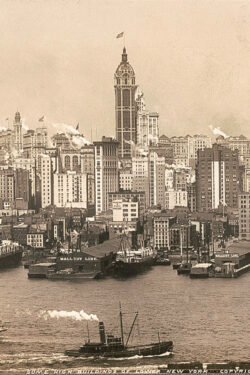Two scholars of the skyscraper, Gail Fenske and Carol Willis address an opposition that has long characterized the framework for understanding the history of tall buildings – corporate vs. commercial – and ask: “What do those words mean, and how do they apply to skyscraper history?”
The program focuses on use, which architects generally call “program.” Office, residential, manufacturing, and commercial (meaning rental) are the terms that generally describe the different uses of high-rise buildings. Yet, one can argue that the most basic commonality in the vast majority of skyscrapers is that they are buildings erected to produce space for rent: i.e., all these uses are urban commercial architecture.
The idea of “corporate architecture” as applied to skyscrapers needs new scrutiny, especially in the early age of the rise of the corporation in the U.S. and especially in New York City in the last decades of the 19th century. Certainly, corporate headquarters, “branding,” and competition played a role in the inspiration and investment in early skyscrapers, as Fenske illustrates. But, as Willis argues, most “corporate” buildings included a significant portion of rental space, and from the 1890s, speculative real estate drove both the height and volume of high-rise construction.
This discussion builds on several past lectures at The Skyscraper Museum by each speaker: the videos of these previous talks are highly recommended as background.
Gail Fenske, The Woolworth Building: Highest in the World (2013)
Speakers
Gail Fenske is author of The Skyscraper and the City: The Woolworth Building and the Making of Modern New York (University of Chicago Press, 2008) and co-editor of Aalto and America (Yale University Press, 2012). She is Professor of Architecture in the School of Architecture, Art & Historic Preservation at Roger Williams University and has taught as a visiting professor at Cornell, Wellesley, and MIT. She is also a licensed architect and has practiced architecture in Boston and New York. She holds a Ph.D. in the history, theory, and criticism of architecture from MIT.
Carol Willis is the founder, director, and curator of The Skyscraper Museum. She is the author of Form Follows Finance: Skyscrapers and Skylines in New York and Chicago (Princeton Architectural Press, 1995), among other publications. An Adjunct Associate Professor of Urban Studies at Columbia University's GSAPP, she teaches in the program Shape of Two Cities: New York and Paris.
